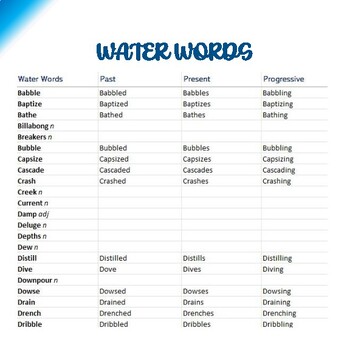600+ Descriptive Writing Words for Natural Elements! Use for Narrative Imagery!⭐
- PDF
Description
Lists of Words for Descriptive Writing
Are you bored when you read your students' descriptive writing? Are their stories and Mad Libs stuffed with cookie-cutter words?
If so, this descriptive writing words list will rekindle interest & revitalize their texts!
Why Focus on Natural Elements?
Nature surrounds us and engages all of our senses. It is the most visceral connection beyond our connection with loved ones. So, descriptive words for fire, water, earth & wind elevate meaning in most texts.
Every story beckons us to read it, to feel something, and to be transformed somehow. A setting can hypnotize, conflict can percolate, and a relationship can combust!
⭐⭐⭐⭐⭐⭐⭐⭐⭐⭐⭐⭐⭐⭐⭐⭐⭐⭐⭐⭐⭐⭐⭐⭐⭐⭐⭐
What You Get
This list of descriptive words for narrative writing comprises 28 pages/slides of vibrant verbs, adjectives, & nouns that will transform texts from passive to active and enliven Mad Libs!
Inside this resource, you get:
⏩ Lists of descriptive words related to a specific natural element;
⏩ Hundreds of words per list, organized alphabetically;
⏩ Labels beside adjectives & nouns to identify the part of speech;
⏩ Three tenses for all verbs: past tense, present singular tense, and progressive tense;
⏩ Differentiated words so all students will find something they can use;
⏩ Some more challenging words useful for growing vocabulary;
⏩ A bonus list of descriptive words for ice - useful for frosty situations!
⭐⭐⭐⭐⭐⭐⭐⭐⭐⭐⭐⭐⭐⭐⭐⭐⭐⭐⭐⭐⭐⭐⭐⭐⭐⭐⭐
Suggested Use
Print this attractive PDF and give it to students as a handout for reference. Or, you can post these words for mad libs and narratives on Google Docs, Edmodo, Schoology, or another program for reference by laptop.
Students can use this descriptive writing words list:
➡️ While writing a story;
➡️ While answering a writing prompt;
➡️ To choose the most precise vocabulary for a presentation;
➡️ To revise a text, infusing it with compelling vocabulary;
➡️ To infuse a story with imagery;
➡️ To elicit emotion;
➡️ As a verb, noun, & adjective words list for Mad Libs;
➡️ For a lesson or activity on denotation & degrees of connotation;
➡️ To practice using the word that best illustrates what they are describing;
➡️ To increase vocabulary;
➡️ To inspire students to research & generate even more descriptive words!
Students who encounter some of these descriptive words for the first time will benefit from access to dictionaries and contextual examples.
Samples of Vocabulary Included in the Descriptive Writing Words List
〰️Descriptive Writing Words for Fire: torrid, volatile, swelter, stoke, refine
〰️Descriptive Writing Words for Water: submerge, filter, hydrate, drain, eddy
〰️Descriptive Writing Words for Earth: trudge, buckle, cavern, anchor, delve
〰️Descriptive Writing Words for Wind: puff, drift, bluster, billow, airburst
❄️Descriptive Writing Words for Ice: slick, cleave, snap, careen, circumpolar
More Writing Resources
For an expository writing tool that helps with short answers and essay writing, check out Concrete Tips for Explaining.
Or, let your students exercise their knowledge of parts of speech & descriptive words by filling out a Mad Lib or two!
Follow My Store
You will find a variety of ELA resources in my store, whether you need comprehension questions, bell ringers, writing prompts, WebQuests, vocabulary, questions for Socratic Seminar, or assessments!
You can follow my store for the latest resources by clicking the ⭐ next to my profile pic.
I hope this descriptive writing words list helps make your teaching sing!
Best,
ELA Content Canary





